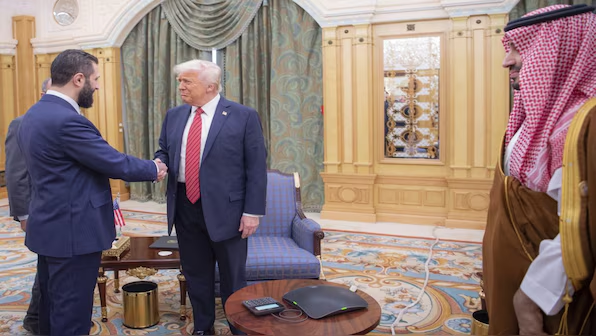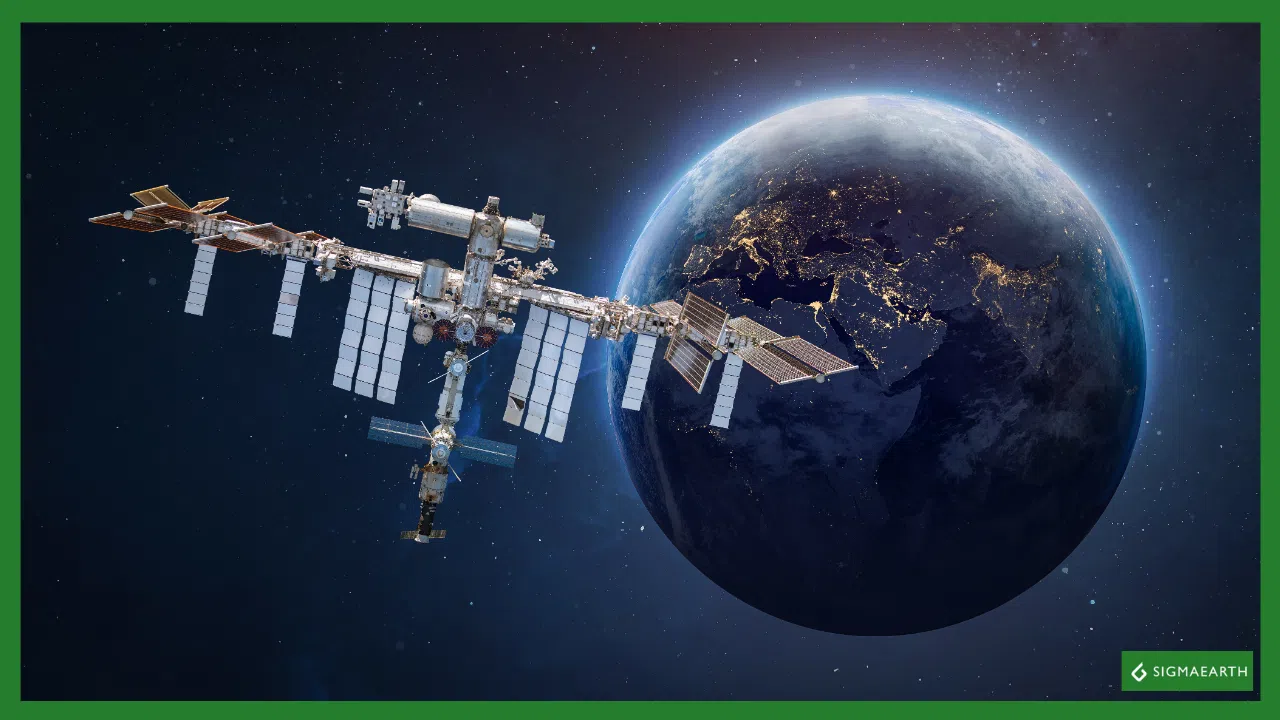- Courses
- GS Full Course 1 Year
- GS Full Course 2 Year
- GS Full Course 3 Year
- GS Full Course Till Selection
- Online Program
- GS Recorded Course
- NCERT (Recorded 500+ Hours)
- Polity Recorded Course
- Geography Recorded Course
- Economy Recorded Course
- AMAC Recorded Course
- Modern India, Post Independence & World History
- Environment Recoded Course
- Governance Recoded Course
- Science & Tech. Recoded Course
- International Relations and Internal Security Recorded Course
- Disaster Management Module Course
- Ethics Recoded Course
- Essay Recoded Course
- Current Affairs Recoded Course
- CSAT
- 5 LAYERED ARJUNA Mentorship
- Public Administration Optional
- ABOUT US
- OUR TOPPERS
- TEST SERIES
- FREE STUDY MATERIAL
- VIDEOS
- CONTACT US
US Lifting Sanctions on Syria – A Major Foreign Policy Shift
US Lifting Sanctions on Syria – A Major Foreign Policy Shift
20-05-2025

1. Context
- On May 13, 2025, US President Donald Trump announced plans to lift most sanctions on Syria.
- This decision comes after the fall of Bashar al-Assad’s regime in December 2024.
- Syria’s new leader, Ahmed al-Sharaa, is heading a transitional government.
- Trump made the announcement during a Saudi investment conference in Riyadh, attended by Gulf and regional leaders.
- He said lifting sanctions would give Syria a chance at “greatness”, and help the country recover after years of war and destruction
2. Background: US Sanctions on Syria
- 1979: The US first imposed sanctions on Syria after designating it a State Sponsor of Terrorism, mainly for its support to Palestinian and Lebanese militant groups like Hamas and Hezbollah.
- 2004: The US expanded sanctions targeting Syria’s economy and defense sector, cutting off trade and technology access.
- 2011–2019 (Syrian Civil War):
- Sanctions became much stricter under the Caesar Syria Civilian Protection Act.
- Targeted:
- The oil and banking sectors
- Senior officials in Assad’s government, including Assad himself
- Syrian military and intelligence agencies
- The focus was on punishing human rights abuses, war crimes, and violent crackdowns on civilians.
3. Why Is the US Changing Its Policy Now?
a) Fall of the Assad Regime
- After more than a decade of war, Assad’s government was overthrown in December 2024.
- The new leadership under Ahmed al-Sharaa took control after a coalition of rebel and regional forces pushed Assad out.
- Since most US sanctions were tied to Assad’s regime, his removal gives the US a legal and political reason to lift them.
b) Pragmatic Approach to New Leadership
- Al-Sharaa was previously part of Jabhat al-Nusra, a group linked to al-Qaeda.
- He broke ties with al-Qaeda in 2016 and later became part of the anti-Assad coalition.
- While his past is controversial, the US is now focusing on realistic diplomacy, not past affiliations.
c) New Syrian Government Seen as Moderate
- Al-Sharaa’s transitional government has taken several positive steps:
- United various sectarian militias into a single national military.
- Avoided religious extremism and ideological language.
- Shown interest in international partnerships.
- Indicated openness to recognizing Israel through the Abraham Accords.
- Committed to fighting ISIS and restoring stability.
4. What Is the US Strategy in the Middle East Now?
a) Less Military, More Economic Focus
- Trump’s new approach moves away from US military involvement.
- He supports “regionally-owned” conflict resolution, where local powers take the lead.
- Syria is expected to:
- Rebuild its economy with help from the Gulf.
- Take charge in fighting extremist groups like ISIS.
b) Massive Trade Deals
- During the trip, Trump signed $1 trillion worth of deals:
- $600 billion with Saudi Arabia, including a $142 billion arms deal.
- $243.5 billion with Qatar.
- $200 billion with the UAE.
- In return, Gulf countries:
- Are investing in the US economy.
- Giving Trump personal favors like:
- A custom-built Air Force One jet from Qatar.
- Real estate partnerships linked to Trump companies.
- Are also working with Elon Musk’s Starlink to expand digital infrastructure in the Gulf.
c) New Groupings (Minilateralism)
- Trump is pushing for small group alliances like I2U2 (India, Israel, UAE, USA).
- These are economic and tech-focused, not military alliances.
- Syria may be invited to join the Abraham Accords, aligning it with Gulf-Israel-US trade partnerships.
5. Israel’s Concerns
- Israel is worried that lifting sanctions will empower a hostile Syrian neighbor, even if Assad is gone.
- Israel also sees al-Sharaa’s past terrorist links as a security risk.
Additional Concerns:
- The US is:
- Re-engaging with Turkey, allowing it back into the F-35 fighter program.
- US also Signed a $304 million missile deal with Turkey.
- Talking with Iran for a possible nuclear deal.
- Iran may give up enriched uranium for sanctions relief.
- In return, the US stopped airstrikes on Houthis (Iran-backed group in Yemen) to reduce Red Sea attacks.
- Israel’s position:
- Feels isolated.
- Says it will defend itself without relying on the US, especially against Iran and Syrian threats.
6. Global and Local Reactions
a) Inside Syria
- Celebrations broke out in cities like Homs and Latakia.
- People waved Syrian and Saudi flags, chanted pro-Saudi slogans, and watched fireworks.
- Many see this as the start of Syria’s rebuilding journey.
b) Syria’s Leaders React
- Foreign Minister Al-Shaibani thanked the US and Gulf countries.
- Called this a “new beginning” for Syria’s recovery.
- Said once Syria is back on SWIFT banking, funds will flow from:
- Syrian diaspora
- Friendly nations
- Economy Minister Nidal al-Shaar gave an emotional speech on Al Arabiya, saying:
- This marks the start of an economic renaissance.
- Syria is ready for trade and investment.
- Citizens will soon feel relief and recovery.
c) US Domestic Reactions
- Bipartisan political support:
- Democrat Jeanne Shaheen and Republican Jim Risch backed the move.
- Lindsey Graham was more cautious:
- Said the Syrian leadership came to power through violence, not elections.
- Promised to stay in close contact with Israel and Turkey to monitor the situation.
d) United Nations Response
- UN Envoy Geir Pedersen welcomed the US decision.
- Said it will:
- Help restore health services, education, and basic needs.
- Revive Syria’s collapsed economy.
7. Implications for India
a) Economic and Strategic Opportunities
- India can benefit from:
- Infrastructure and reconstruction projects in Syria.
- Participation in the IMEC (India-Middle East-Europe Corridor).
- Greater access to energy, trade routes, and connectivity to Europe.
b) Strengthening India-Gulf Ties
- Gulf countries like UAE and Saudi Arabia are:
- India’s top energy suppliers.
- Home to over 9 million Indian workers.
- Now also key economic partners.
- Their focus on diversification and development aligns with India’s Act West Policy.
c) Third-Party Mediation Risks
- Trump claimed credit for reducing India-Pakistan tensions, which India rejects.
- Saudi Arabia may offer to mediate more in future.
- India must firmly reject third-party involvement, especially in Kashmir.
d) Caution on Political Risks
- Trump’s diplomacy is closely tied to his business interests.
- India should be careful in economic groupings where private gains may affect foreign policy.
- Strategic choices must be made keeping long-term interests and stability in mind.
Conclusion
The US decision to lift Syria sanctions is a turning point in regional politics. It shows a move from military solutions to economic deals and diplomacy. For Syria, it opens the path to recovery, rebuilding, and global reintegration. For India, it creates fresh opportunities, but also calls for careful navigation in a changing West Asia.




